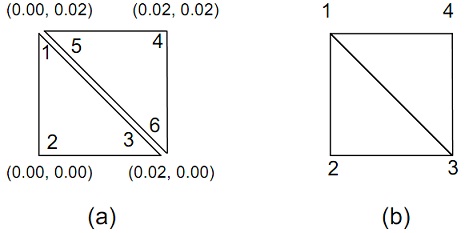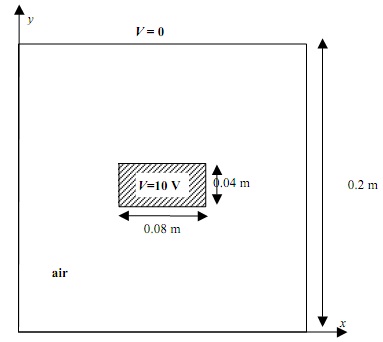problem 1: Figure below shows two first-order triangular finite elements used to solve the Laplace equation for electrostatic potential. Find out a local S-matrix for each triangle, and a global S-matrix for the mesh which comprises of just these two triangles. The local (disjoint) and global (conjoint) node-numberings are shown in figure (a) and (b), respectively. Also, figure (a) shows the (x, y)-coordinates of the element vertices in meters.

problem 2: Figure below shows the cross-section of an electrostatic problem with translational symmetry: a rectangular coaxial cable. The inner conductor is held at 10 volts and the outer conductor is grounded.
a) Use the two-element mesh shown in Figure 1(b) as a 'building block' to construct a finite element mesh for one-quarter of the cross-section of the coaxial cable. Specify the mesh, comprising boundary conditions, in an input file following the format for the SIMPLE2D program.
b) Use the SIMPLE2D program with the mesh from part (a) to find out the electrostatic potential solution. Find out the potential at (x, y) = (0.06, 0.04) from the data in the output file of the program.
(c) Caculate the capacitance per unit length of the system using the solution obtained from SIMPLE2D.
Note: The SIMPLE2D program and related utility programs are available from the myCourse page for this course or on the World-Wide-Web at:
http://www.cambridge.org/catalogue/catalogue.asp?isbn=0521449537&ss=res
Please read the file README.1ST before using the software.

problem 3: prepare a program implementing the conjugate gradient method (un-preconditioned). Solve the matrix equation corresponding to a finite difference node-spacing, h = 0.02m in x and y directions for the same one-quarter cross-section of the system shown in figure above that considered in problem 2 above. Use a starting solution of zero.
a) Test your matrix by using your Choleski decomposition program which you wrote for problem 1 to make sure that it is positive definite. If it is not, suggest how you could modify the matrix equation in order to use the conjugate gradient method for this problem.
b) Once you have modified the problem so that the matrix is positive definite, solve the matrix equation first by using the Choleski decomposition program, and then the conjugate gradient program written for this assignment.
c) Plot a graph of the infinity norm and the 2-norm of the residual vector versus the number of iterations for the conjugate program.
d) What is the potential at (x,y) = (0.06, 0.04), by using the Choleski decomposition and the conjugate gradient programs, and how do they it compare with the value you find outd in problem 2(b) above. How do they compare with the value at the same (x,y) location and for the same node spacing that you computed in Assignment 1 using SOR.
e) Recommend how you could find out the capacitance per unit length of the system from the finite difference solution.